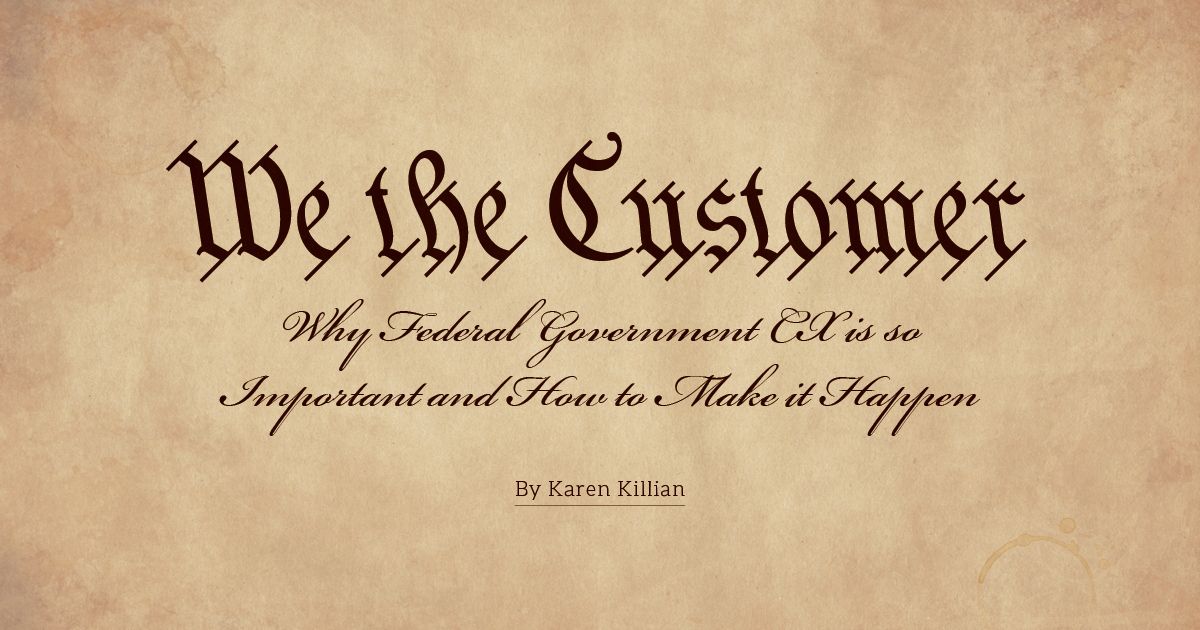Customer experience (CX) isn’t a new concept. Companies like Target, Zappos, Wegmans, and Trader Joe’s are known for putting customers at the center of their business models. Great CX is an inherent part of their culture that impacts everything from operations to human resources to marketing and beyond.
What is new is that the federal government is now embracing customer experience more than ever before. CX started to gain the attention of the federal government in 2015, and over the last six years, many government agencies have put resources and real effort behind a variety of CX initiatives. However, metrics show that these initiatives have earned very modest increases in customer satisfaction and that performance across agencies was uneven at best.
But why is CX so important for federal agencies—and how can the government make real strides toward improving CX?
The Why
From paying taxes to getting a small business loan to applying for a passport, federal programs are inextricably woven into our day-to-day lives. Many of these programs are supposed make our lives better—but how can they accomplish that goal if we’re buried in forms, can’t find the information we need, or get stuck in endless automated telephone trees?
The federal government exists for “we, the people”—and its agencies have missions to advance that largely focus on citizens: protecting us, keeping us safe, meeting our needs, and so on. But when customers turn to a government agency for help and get frustrated by their interactions, they’re less likely to:
- Comply with agency directives, guidance, and advice.
- Seek out official information.
- Apply for benefits and services.
The federal government has also become more interested recently in performance metrics—that is, measuring whether or not agencies are meeting their mission goals. When customers don’t do the three things listed above, agencies have a much harder time achieving their goals—and when they don’t, they may come under scrutiny from Congress, the Government Accountability Office, the General Services Administration, the Office of Management and Budget, and even their own leadership and internal affairs.
Poor CX within government agencies can also harm:
- Employee morale. When agencies make services difficult to deliver, the internal culture suffers. When employees aren’t happy, they’re even less likely to try to make customers happy.
- Public relations. From a PR standpoint, poor CX isn’t a good look. When elected officials get complaints about their experience dealing with agencies from their constituents, they may feel obligated (or pressured) to respond publicly, drawing even more attention to the problem.
- Credibility and trust. Trust in government is crucial to voluntary compliance with laws, policies, and regulations. Lack of credibility and trust makes it harder for the government to solve our country’s problems—and even to trust each other. According to a recent national survey by the Pew Research Center, some respondents correlated poor government performance with the toll it has taken on their fellow citizen’s hearts.
Alternatively, government agencies that master CX see positive impacts on:
- Employee satisfaction and retention. Just as poor CX can tank morale, positive experiences with customers and efficient operations lead to employees who take pride in their work and their agency.
- Compliance. When customers feel satisfied and heard, they're more likely to comply with the policies and procedures an agency requires. Increased compliance also means fewer programmatic and policy-related bumps in the road.
- Operational productivity and efficiency. Building good CX often means making changes to an organization’s operations to best suit the customer and organization personnel.
- Recruitment. An agency that's generating good word of mouth and has satisfied employees will find that top candidates want to work there.
- Brand image. Satisfied customers mean good word-of-mouth, which means good PR.
- Private sector partnerships and Congressional support. This comes with all the above benefits: an agency with efficient operations, top talent, and great PR will find willing, engaged partners.
The How
The good news is the federal government is doing some things right when it comes to CX. Agencies like the Veterans Administration, the National Weather Service, and the National Park Service know that great CX doesn’t just happen—it must be a priority for the entire agency, and it cuts across many different aspects of agency operations, including:
-
Leadership. Great CX starts at the top of the organization. When an agency’s leadership prioritizes CX, creates a mission and vision for how to improve it, and reinforces that mission and vision at every opportunity, employees begin to fall in line.
- Strategy. As the saying goes, “fail to plan, plan to fail.” The mission and vision for CX must be supported by clearly articulated goals and strategies for achieving those goals that are shared across the entire agency. People need to know what they’re shooting for and how they will get there.
- Policy. Not only should an agency have detailed policies for CX delivery that guide its employees’ interactions with customers, it should consider its customers when designing programs and policies for them.
- Culture. Agencies need to develop a CX-focused culture that encompasses employee engagement, hiring, and human resource policies.
- Marketing. Treating CX as an integral part of the brand ensures that an agency will meet its customers at every point in their journey and reinforces a "CX culture."
- Data. Agencies must develop a deep understanding of what matters to their customers—and customer data can help inform that understanding. From program usage patterns to customer satisfaction surveys to requests for public comments, customer insights can be obtained from many different sources.
- Technology. Technology can make the job of delivering great CX easier, but it’s also a means to that end. Agencies frequently get caught up in the excitement—and the chaos—of a big change management project, like implementing a new customer service system. They must remember the reason they’re implementing that technology: to make their customers’ lives better.
- Measurement. You won’t know if you’ve improved your agency’s CX unless you measure it. Promoter scores, Foresee® survey results, data analytics, and qualitative customer information can tell you if your agency is on the right track (and improving).
Clearly, there’s more work to be done. The Office of Management & Budget updated its guidance on customer experience in August 2020, and the consulting group Forrester recently recommended that the Biden administration create a federal chief customer officer.
Does your agency need help developing a CX program? LMD can help.

